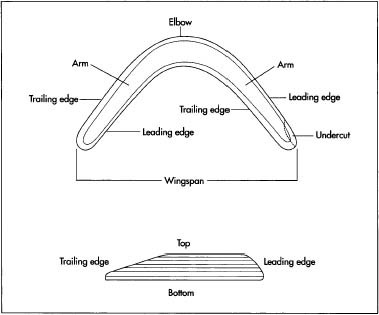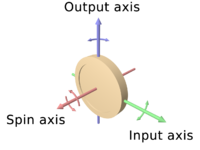Thousands of years ago, early hunters discovered that a single bend in a piece of wood gave it some interesting aerodynamics properties. Tossed vertically, a boomerang will fly in a loop, returning to its thrower. How is such a seemingly simple object able to move through the air so remarkably? When we examine the boomerang closer, we find that its design is unintentionally rather complex, producing a number of forces working simultaneously.

Firstly, The two arms of the boomerang essentially act like wings, both having a thin side and a rounded side, forming airfoils. Since it will be spinning around its central point counterclockwise though, and the airfoils are facing different directions, the leading edges are on opposite sides of the boomerang.
Unlike how wings traditionally cut through the air, a boomerang is thrown vertically. To make it easier to visualize its movement, one may want to think of it more like a propeller. This “propeller” creates the same horizontal lift that an ordinary one does.

But a propeller is attached to a plane. Its blades are moving perpendicular to the direction of the aircraft. The boomerang, on the other hand, is moving in the direction that it is spinning.
Thrown correctly, it is spinning counterclockwise. What this means is that, at any moment, the arm that is on top is spinning in the direction that the entire boomerang is traveling, while the arm on the bottom is spinning in the opposite direction. Thus, the top arm is moving relatively faster, creating more lift than the bottom one.
Since there is always greater lift being produced at the top of the boomerang, it seems that this should push it over (like if one were to apply force to a stationary wheel), so that it would be parallel to the ground. Why is this not the case?

Simply, it is an example of the gyroscope effect. Put clearly by Tom Harris, “When you push a spinning wheel, for example, the wheel reacts to the force as if you pushed it at a point 90 degrees off from where you actually pushed it”. The force was applied to a single point on the boomerang, so as the arms spin, so does the point that was pushed. Consequently, the boomerang turns to the left instead of falling over. It begins to fly in a circular motion, eventually returning to its thrower.
To fully understand the physics of a boomerang, I would highly recommend watching the animations on the HowStuffWorks website that I posted, since I unfortunately could not embed them.
Sources:
3 Comments
Lorena Barba posted on October 21, 2011 at 8:23 pm
You forgot to list your sources …
Lorena Barba posted on October 21, 2011 at 8:25 pm
Can you think of any instance in nature where similar mechanics apply?
Luke Loreti posted on October 21, 2011 at 10:54 pm
Sorry about that, fixed. The only possible examples I cant think of in nature would maybe be tree seedlings. When they’re on they’re descent, if they were disturbed, I’m thinking the gyroscope effect would right them so that they could continue spinning downwards.